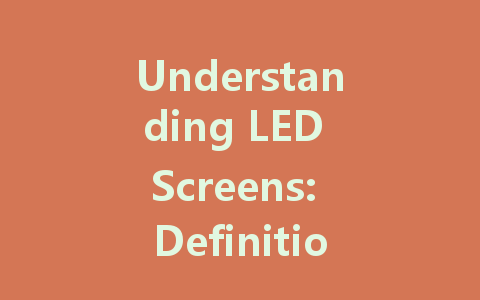
In today’s digital age, LED screens have become commonplace in various settings, from homes to businesses, and even in public spaces. These vibrant displays are not just popular for their stunning visuals but also for their versatility and efficiency. In this article, we’ll delve into the definition of LED screens, explore their various uses, and discuss the numerous benefits they offer.
What is an LED Screen?
LED stands for Light Emitting Diode, which is a semiconductor device that emits light when an electric current passes through it. LED screens use these diodes to create images by illuminating individual pixels, thus forming a complete display. Unlike traditional screens, such as LCDs or CRTs, LED screens are significantly thinner, lighter, and capable of showcasing a wider spectrum of colors.
Types of LED Screens
LED screens come in several varieties to cater to different needs and environments. Here are a few common types:
Indoor LED Screens
These are used in settings such as shopping malls, conference rooms, and homes. Indoor LED screens typically have a higher pixel density, which results in sharper images viewed from a closer distance. They are popular for advertising and displaying video content.
Outdoor LED Screens
Designed to withstand the elements, outdoor LED screens are often larger and have a lower pixel density. They are used for billboards, sports stadiums, and public events, making them highly effective for reaching larger audiences from a distance.
Flexible LED Screens
Innovative in design, flexible LED screens can be bent or shaped to fit various applications. They’re often used in event staging and creative advertising, allowing for dynamic presentations that can transform spaces.
Transparent LED Screens
These screens are perfect for creating eye-catching displays without obstructing views. Typically seen in retail environments and exhibitions, transparent LED screens allow for promotional content while maintaining visibility through glass.
Common Uses of LED Screens
LED screens serve a multitude of purposes across various sectors.
Advertising
LED screens are a favorite among marketers for their bright, engaging displays, which grab attention easily. From storefront promotions to big event announcements, businesses leverage LED technology to enhance their visibility and attract customers.
Entertainment
In the entertainment industry, LED screens are pivotal in concerts, festivals, and theaters. They provide stunning visuals that enhance performances, making them a staple in modern entertainment venues.
Information Display
Many organizations use LED screens to display information, such as schedules, menus, and notifications. Airports, train stations, and conference centers often rely on LED displays for effective communication with passengers and visitors.
Home Entertainment
In homes, LED screens are prevalent in the form of televisions and computer monitors. Their quality and energy efficiency make them ideal for a superior viewing experience.
Benefits of LED Screens
LED screens are not only about aesthetics; they pack a range of advantages:
Energy Efficiency
One of the standout benefits of LED technology is energy efficiency. LED screens consume significantly less power compared to traditional displays, making them a more sustainable choice. This reduction in energy consumption translates to lower electricity bills—a major plus for both consumers and businesses.
Longevity
LED screens are known for their long lifespan. With proper care, they can last for several years without a significant drop in performance. This durability means less frequent replacements and lower overall costs in the long run.
Brightness and Clarity
LED screens provide a higher brightness level, making them suitable for various lighting conditions, including daylight. The clarity of images and colors displayed on LED screens enhances visual experiences, making them ideal for both indoor and outdoor settings.
Thin and Lightweight Design
LED technology allows for thinner and lightweight screens, which simplifies installation and transport. This feature is particularly beneficial for temporary setups, such as events and exhibitions.
Conclusion
Understanding LED screens is crucial in today’s technology-driven world. Their ability to deliver stunning visuals, coupled with their energy efficiency and versatility, makes them a popular choice across various industries. Whether used for advertising, entertainment, or information display, LED screens are here to stay, transforming the way we communicate and interact with visual content. Whether you are considering an outdoor display for your business or upgrading your home entertainment system, LED technology offers numerous benefits that make it a worthy investment.